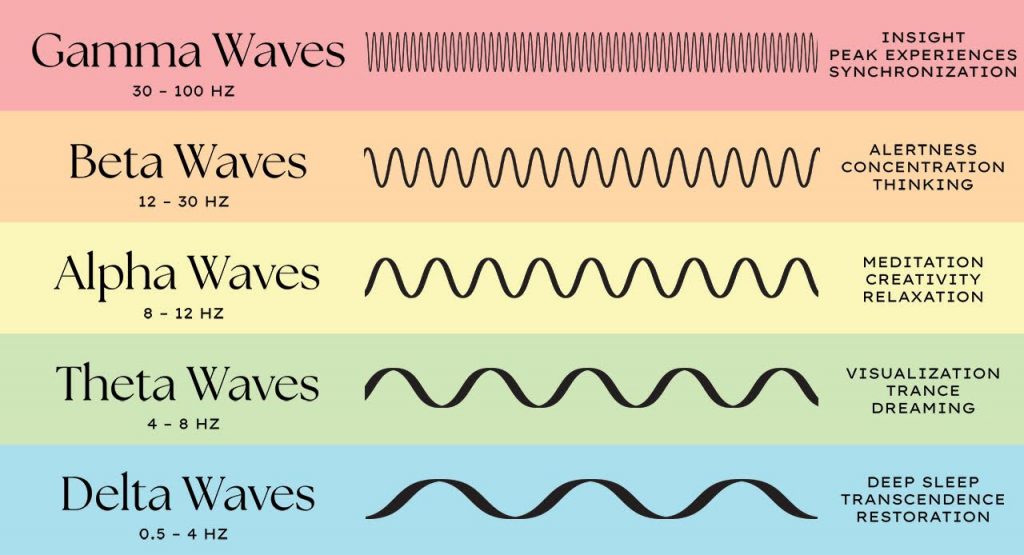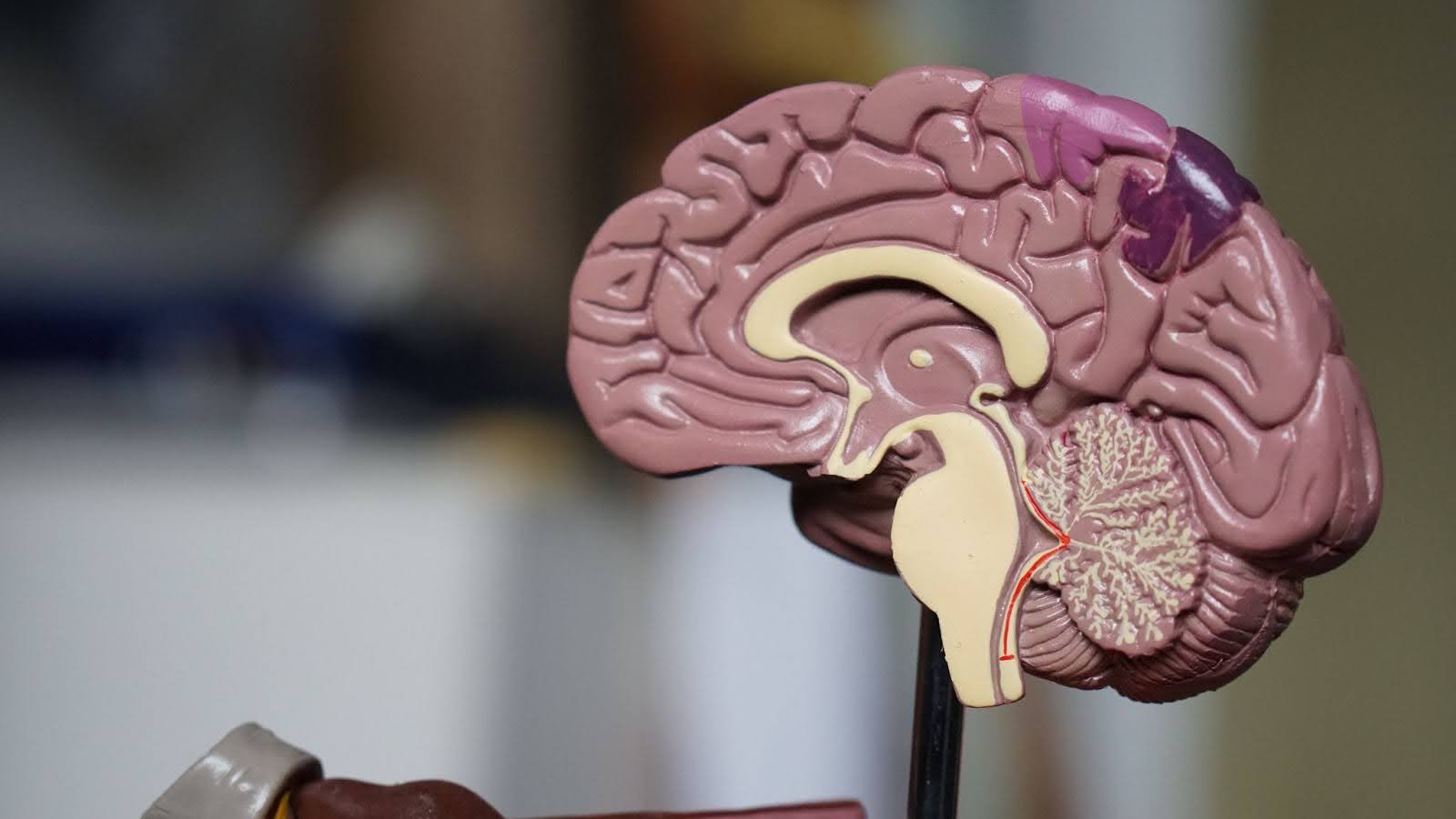The Traditional View
Death has inspired countless philosophical, theological, and scientific studies. Clinically, death occurs when heartbeat and respiration cease, and it has long been believed that when the body’s processes shut down, the brain does as well. However, a strange phenomenon described in a May 2023 study raises questions about whether death should be determined by heart functionality: scientists from the University of Michigan School of Medicine revealed that brain activity surges as a human dies.1

Brain activity is measured through electroencephalogram (EEG) machines. The EEG displays waves that represent brain oscillations, or brain waves, that can be categorized into five frequency ranges, the lowest being delta oscillations (0.5 – 4 Hz) that occur during deep sleep or unconsciousness (See Figure 1).2 Scientists that worked on researching the surge of brain activity after death detected gamma oscillations in the dying human brain, which is the highest frequency category (32 – 100 Hz) occuring during problem solving, learning, and heightened perception. This surprising surge may begin to answer the question about what happens after death and offer evidence for the narrative that your life “flashes” before your eyes as you die.
Diving into the Strange Spike
Measurements from EEG machines measured brain activity of four dying patients before and after their ventilators were removed. During the EEG, electrodes are pasted onto the scalp in various regions where different readings can be extracted. These placements are based on the roles of the different areas of the brain. The readings were also categorized into 11 different stages. Baseline periods (stage 1, or S1) were chosen within the last few hours of patients’ life while they were receiving full life support, including ventilation. Stage 2 (S2) represents the period from the time of ventilator removal until the acute EEG suppression seen in all patients. Acute EEG suppression refers to a sudden and profound decrease in brain electrical activity as recorded by EEG, often associated with conditions such as anesthesia, severe brain injury, or certain medical interventions.
A reading derived from the T3 (the left anterior mid temporal lobe) region of one patient exhibited a gamma power surge close to the start of death that increased within seconds after the patient’s ventilator was removed. This area of the brain is responsible for the brain’s memory and auditory processing. A similar elevation is seen in another patient during Stage 2, instead in the front and central areas of the brain. These areas are attributed with personality characteristics, decision making, and movement.3 An increase of gamma power is visible in the later stages, showcasing the unique phenomenon.

Connecting the surge to Near Death Experiences
Anecdotal evidence suggests that Near Death Experiences (NDEs) are often accompanied by feeling as though one is leaving their body, seeing a brilliant light, seeing loved ones who have passed away, or experiencing a sense of calm and wellbeing. This increase in brain activity, according to Dr. Sam Parnia, a critical care physician and the author of “The Lazarus Effect,” may contribute to NDEs.4, 5 He hypothesizes that it would be possible for consciousness to endure briefly after clinical death, explaining the vivid experiences that some who have survived the edge of death have described.
While the concept challenges conventional views on the finality of death, it could explain the aforementioned commonly seen elements associated with NDEs. The intricate workings of the brain, even in its dying moments, may give rise to a heightened state of awareness. This heightened state could lead to the subjective experiences described by those who have returned from the brink of death. Understanding the neurobiology of these events is a complex challenge, but it opens up fascinating possibilities for exploring the nature of consciousness and the mysteries surrounding death.
It’s important to note that while these ideas are intriguing, the scientific community is still exploring and debating the nature of NDEs, and the subject remains an area of ongoing research and discussion. Dr. Parnia’s work contributes to the growing body of knowledge that seeks to unravel the enigma of what happens to the mind and consciousness as the body faces the threshold of mortality.
Implications for the Nature of Consciousness and Ethical and Philosophical Considerations
The increase in brain activity directly after death challenges the idea that consciousness is solely a product of brain function. According to some experts, this phenomenon may lend credence to theories of a more intricate, interconnected understanding of consciousness that goes beyond the physical brain.
The discovery of an increase in brain activity after death also calls into question the morality of organ donation and end-of-life decisions. When does death really occur if the brain continues to show signs of activity after medically determined death? Which criteria for organ donation and transplantation might be modified by this new understanding? As we investigate this fascinating area of research, these are challenging questions that demand careful consideration.
Conclusion
While the termination of a beating heart has traditionally been thought to mark the end of life, these recent discoveries cast doubt on this notion and raise fascinating concerns about the nature of consciousness, near-death encounters, and the afterlife. Long-held ideas about the instant of passing and its relationship to consciousness are called into question by the spike in brain activity that occurs after death. Even though scientific research on this phenomenon is still in its infancy, it has the potential to fundamentally alter how we think about what happens before, during, and after death. It might provide fresh perspectives on how mysterious near-death experiences are and how the brain and consciousness interact. As this field of study develops, new insights into life, death, and the human condition are likely to become clear.
Acknowledgements:
Thank you to Dr. Silvia Bunge of the UC Berkeley Psychology Department for their contributions and review.
Citations
- Xu, Gang, et al. “Surge of neurophysiological coupling and connectivity of gamma oscillations in the dying human brain.” Proceedings of the National Academy of Sciences, vol. 120, no. 19, 2023, https://doi.org/10.1073/pnas.2216268120.
- neural oscillation | Definition, Types, & Synchronization. (n.d.). Encyclopedia Britannica. https://www.britannica.com/science/brain-wave-physiology
- Brain anatomy and how the brain works. Johns Hopkins Medicine. (2021, July 14). https://www.hopkinsmedicine.org/health/conditions-and-diseases/anatomy-of-the-brain#:~:text=The%20largest%20lobe%20of%20the,is%20associated%20with%20speech%20ability
- Parnia, S., Post, S. G., Lee, M. T., Lyubomirsky, S., Aufderheide, T. P., Deakin, C. D., Greyson, B., Long, J., Gonzales, A. M., Huppert, E. L., Dickinson, A., Mayer, S., Locicero, B., Levin, J., Bossis, A., Worthington, E., Fenwick, P., & Shirazi, T. K. (2022). Guidelines and standards for the study of death and recalled experiences of death––a multidisciplinary consensus statement and proposed future directions. Annals of the New York Academy of Sciences. https://doi.org/10.1111/nyas.14740
- Parnia, S. (2006). What Happens when We Die: A Groundbreaking Study Into the Nature of Life and Death. In Google Books. Hay House, Inc. https://books.google.com/books?hl=en&lr=&id=E1z6DwAAQBAJ&oi=fnd&pg=PR9&dq=Dr.+Sam+Parnia+NDEs&ots=K-6NaTVX_o&sig=bRbnqq_Vwel-lVWCXzB1Ex64U0g#v=onepage&q=Dr.%20Sam%20Parnia%20NDEs&f=false
- Rethinking Brain Cell Death. (n.d.). NYU Langone Health. Retrieved November 14, 2023, from https://med.nyu.edu/research/parnia-lab/cardiac-arrest-death/rethinking-brain-cell-death#:~:text=Although%20a%20person%20meets%20the
Image references
Cover Photo: Weermeijer, R. (2019). Brown brain decor in selective focus photography. Unsplash. Unsplash.com. Retrieved November 27, 2023, from https://unsplash.com/photos/brown-brain-decor-in-selective-focus-photography-3KGF9R_0oHs.
Figure 1: Pearce, Kyle. “Understanding Brain Waves: Beta, Alpha, Theta, Delta + Gamma.” DIY Genius, 12 Jan. 2024, from www.diygenius.com/the-5-types-of-brain-waves/. Figure 3: Aldra, Alexandra, and Natalia Torreblanca. “EEG Electrode Placement: Fixed vs. Variable.” Bitbrain, 21 Mar. 2024, from www.bitbrain.com/blog/eeg-electrode-placement.
Figure 2: Aldra, Alexandra, and Natalia Torreblanca. “EEG Electrode Placement: Fixed vs. Variable.” Bitbrain, 21 Mar. 2024, from www.bitbrain.com/blog/eeg-electrode-placement.
